Question: Refer to the balance sheet and income
Refer to the balance sheet and income statement for Apple in Appendix A. What does the company title its inventory account? Does the company present a detailed calculation of its cost of goods sold?
Apple’s balance sheet & income statement from Appendix A:
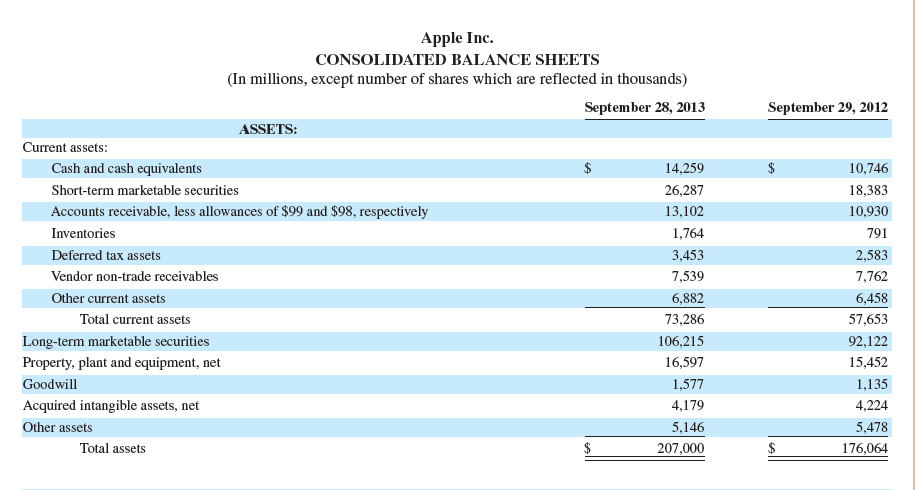
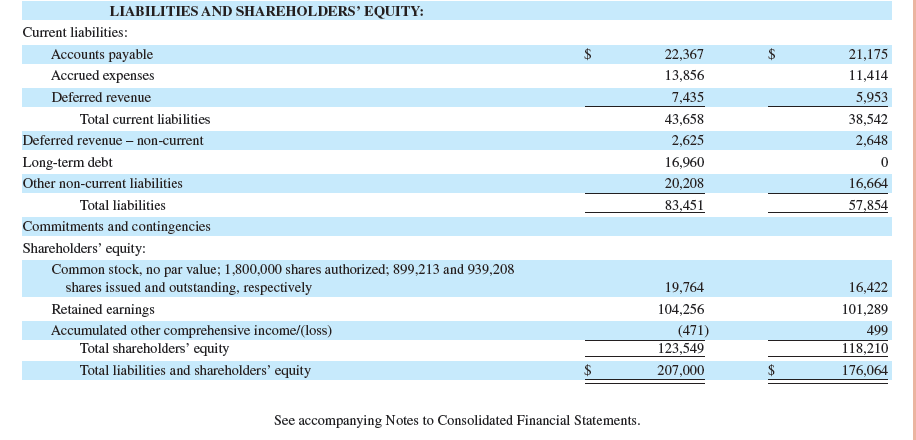
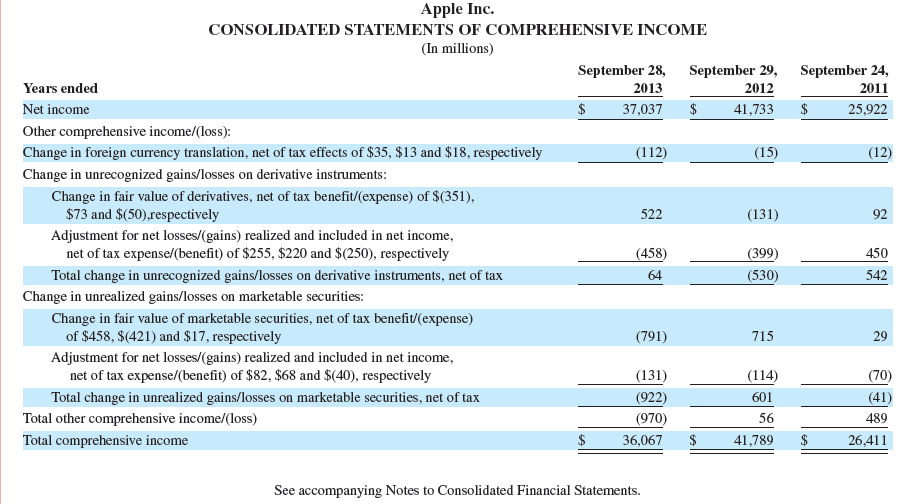
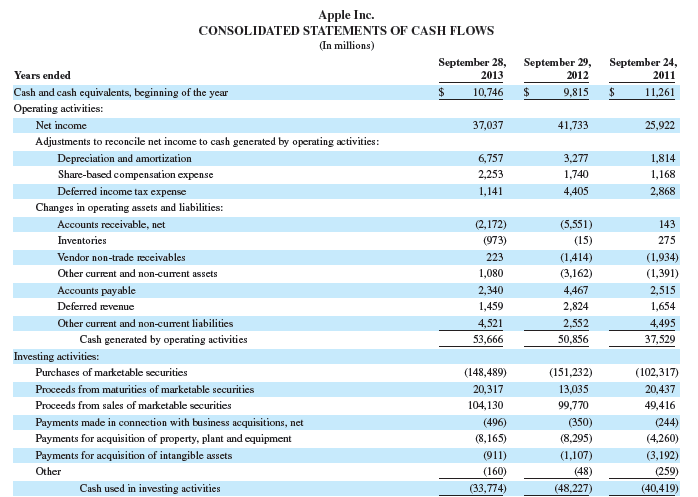
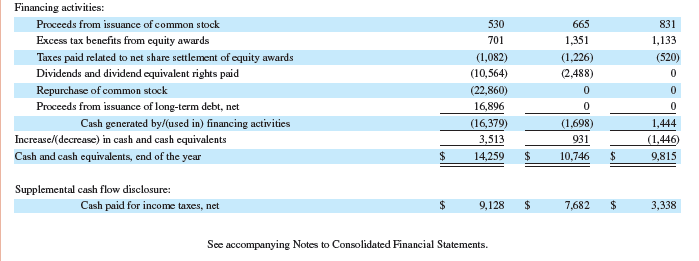
Transcribed Image Text:
Apple Inc. CONSOLIDATED BALANCE SHEETS (In millions, except number of shares which are reflected in thousands) September 28, 2013 September 29, 2012 ASSETS: Current assets: Cash and cash equivalents 14,259 10,746 Short-term marketable securities 26,287 18,383 Accounts receivable, less allowances of $99 and $98, respectively 13,102 10,930 Inventories 1,764 791 Deferred tax assets 3,453 2,583 Vendor non-trade receivables 7,539 7,762 Other current assets 6,882 6,458 Total current assets 73,286 57,653 Long-term marketable securities 106,215 92,122 Property, plant and equipment, net 16,597 15,452 Goodwill 1,577 1,135 Acquired intangible assets, net 4,179 4,224 Other assets 5,146 5,478 Total assets 207,000 176,064 LIABILITIES AND SHAREHOLDERS’ EQUITY: Current liabilities: Accounts payable $ 22,367 $ 21,175 Accrued expenses 13,856 11,414 Deferred revenue 7,435 5,953 Total current liabilities 43,658 38,542 Deferred revenue – non-current 2,625 2,648 Long-term debt 16,960 Other non-current liabilities 20,208 16,664 Total liabilities 83,451 57,854 Commitments and contingencies Shareholders' equity: Common stock, no par value; 1,800,000 shares authorized; 899,213 and 939,208 shares issued and outstanding, respectively 19,764 16,422 Retained earnings 104,256 101,289 499 Accumulated other comprehensive income/(loss) Total shareholders' equity (471) 123,549 118,210 Total liabilities and shareholders' equity 207,000 176,064 See accompanying Notes to Consolidated Financial Statements. Apple Inc. CONSOLIDATED STATEMENTS OF COMPREHENSIVE INCOME (In millions) September 29, 2012 September 24, September 28, 2013 Years ended 2011 Net income $ 37,037 $ 41,733 $ 25,922 Other comprehensive income/(loss): Change in foreign currency translation, net of tax effects of $35, $13 and $18, respectively (112) (15) (12) Change in unrecognized gains/losses on derivative instruments: Change in fair value of derivatives, net of tax benefit/(expense) of $(351), $73 and $(50),respectively Adjustment for net losses/(gains) realized and included in net income, net of tax expense/(benefit) of $255, $220 and $(250), respectively 522 (131) 92 (458) (399) 450 Total change in unrecognized gains/losses on derivative instruments, net of tax 64 (530) 542 Change in unrealized gains/losses on marketable securities: Change in fair value of marketable securities, net of tax benefit/(expense) of $458, $(421) and $17, respectively (791) 715 29 Adjustment for net losses/(gains) realized and included in net income, net of tax expense/(benefit) of $82, $68 and $(40), respectively (131) (114) (70) (922) (970) Total change in unrealized gains/losses on marketable securities, net of tax 601 (41) Total other comprehensive income/(loss) 56 489 Total comprehensive income $ 36,067 $ 41,789 $ 26,411 See accompanying Notes to Consolidated Financial Statements. Apple Inc. CONSOLIDATED STATEMENTS OF CASH FLOWS (In millions) September 28, 2013 September 29, 2012 September 24, 2011 Years ended Cash and cash equivalents, beginning of the ycar 10,746 9,815 %2$ 11,261 Operating activities: Net income 37,037 41,733 25,922 Adjustments to reconcile net income to cash generated by operating activities: Depreciation and amortization 6,757 3,277 1,814 Share-based compensation expense 2,253 1,740 1,168 Deferred income tax expense 1,141 4,405 2,868 Changes in operating assets and liabilities: Accounts receivable, net (2,172) (5,551) 143 Inventories (973) (15) 275 Vendor non-trade receivables 223 (1,414) (1,934) Other current and non-curent assets 1,080 (3,162) (1,391) Accounts payable 2,340 4,467 2,515 Deferred revenue 1,459 2,824 1,654 Other current and non-curent liabilities 4,521 2,552 4,495 Cash generated by operating activities 53,666 50,856 37,529 Investing activities: Purchases of marketable securities (148,489) (151,232) (102,317) Proceeds from maturities of marketable securities 20,317 13,035 20,437 Proceeds from sales of marketable securities 104,130 99,770 49,416 Payments made in connection with business acquisitions, net (496) (350) (244) Payments for acquisition of property, plant and equipment (8,165) (8,295) (4,260) Payments for acquisition of intangible assets (911) (1,107) (3,192) Other (160) (48) (259) Cash used in investing activities (33,774) (48,227) (40,419) Financing activities: Proceeds from issuance of common stock 530 665 831 Excess tax benefits from cquity awards 701 1,351 1,133 Taxes paid related to net share settlement of equity awards (1,082) (1,226) (520) Dividends and dividend equivalent rights paid (10,564) (2,488) Repurchase of common stock (22,860) Proceeds from issuance of long-term debt, net 16,896 Cash generated by/(used in) financing activities (16,379) (1,698) 1,444 Increase/(decrease) in cash and cash equivalents 3,513 931 (1,446) Cash and cash equivalents, end of the year 14,259 $ 10,746 2$ 9,815 Supplemental cash flow disclosure: Cash paid for income taxes, net 24 9,128 24 7,682 24 3,338 See accompanying Notes to Consolidated Financial Statements.
> Classify each of the following items as revenues (R), expenses (EX), or withdrawals (W). 1. Cost of sales (expense) 2. Service revenue 3. Wages expense 4. Owner withdrawal
> Classify the following adjusting entries as involving prepaid expenses (PE), unearned revenues (UR), accrued expenses (AE), or accrued revenues (AR). a. To record revenue earned that was previously received as cash in advance. b. To record wages expense
> Choose from the following list of terms/phrases to best complete the statements below. a. Fiscal year b. Timeliness c. Calendar year d. Accounting period e. Annual financial statements f. Interim financial statements g. Natural business year h. Tim
> Identify the normal balance (debit or credit) for each of the following accounts. a. Fees Earned (Revenues) b. Office Supplies c. Owner, Withdrawals d. Wages Expense e. Accounts Receivable f. Prepaid Rent g. Wages Payable h. Building i. Owner, Capi
> Choose from the following list of terms/phrases to best complete the following statements. a. Accounting b. Identifying c. Recording d. Communicating e. Recordkeeping (bookkeeping) f. Technology g. Language of business h. Governmental 1. reduces the t
> In the blank space beside each adjusting entry, enter the letter of the explanation A through F that most closely describes the entry. A. To record this period’s depreciation expense. B. To record accrued salaries expense. C. To record
> Key comparative figures ($ millions) for both Apple and Google follow. Required 1. What is the total amount of assets invested in (a) Apple and (b) Google? 2. What is the return on assets for (a) Apple and (b) Google? Apple’s beginnin
> Enter the number for the item that best completes each of the descriptions below. 1. Chart 2. General ledger a. A ______ of accounts is a list of all accounts a company uses. b. The ______ is a record containing all accounts used by a company.
> Enter the number for the item that best completes each of the descriptions below. 1. Asset 2. Equity 3. Account 4. Liability 5. Three a. Accounts are arranged into ______ general categories. b. Owner, Capital and Owner, Withdrawals are examples of ___
> The following describe several different business organizations. Determine whether the description refers to a sole proprietorship (SP), partnership (P), or corporation (C). a. Micah Douglas and Nathan Logan own Financial Services, a financial services p
> Order the following steps in the accounting process that focus on analyzing and recording transactions. a. Prepare and analyze the trial balance. b. Analyze each transaction from source documents. c. Record relevant transactions in a journal. d. Post jou
> Match each of the numbered descriptions with the term or phrase it best reflects. Indicate your answer by writing the letter for the term or phrase in the blank provided. A. Audit B. GAAP C. Ethics D. Tax accounting E. SEC F. Public accountants H. IAS
> Many accounting professionals work in one of the following three areas: A. Financial accounting B. Managerial accounting C. Tax accounting Identify the area of accounting that is most involved in each of the following responsibilities: 1. Internal auditi
> Match each transaction or event to one of the following activities of an organization: financing activities (F), investing activities (I), or operating activities (O). a. An owner contributes resources to the business. b. The organization borrows money f
> Part A. Identify the following questions as most likely to be asked by an internal (I) or an external (E) user of accounting information. 1. What are reasonable payroll benefits and wages? 2. Should we make a five-year loan to that business? 3. What are
> Indicate the section where each of the following would appear on the statement of cash flows. O. Cash flows from operating activity I. Cash flows from investing activity F. Cash flows from financing activity 1. Cash purchase of equipment 2. Cash withdra
> The following table shows the effects of five transactions (a through e) on the assets, liabilities, and equity of Mulan’s Boutique. Write short descriptions of the probable nature of each transaction. Assets = Liabilities + Equity
> Four types of adjustments are described in the chapter: (1) prepaid expenses, (2) unearned revenues, (3) accrued expenses, and (4) accrued revenues. Required 1. Form learning teams of four (or more) members. Each team member must select one of the f
> These 16 accounts are from the Adjusted Trial Balance columns of a company’s 10-column work sheet. In the blank space beside each account, write the letter of the appropriate financial statement column (A, B, C, or D) to which a normal account balance is
> Accounting is an information and measurement system that identifies, records, and communicates relevant, reliable, and comparable information about an organization’s business activities. Classify the following activities as part of the identifying (I), r
> If an incorrect amount is journalized and posted to the accounts, how should the error be corrected?
> Why does the recordkeeper prepare a trial balance?
> If assets are valuable resources and asset accounts have debit balances, why do expense accounts also have debit balances?
> Should a transaction be recorded first in a journal or the ledger? Why?
> Are debits or credits typically listed first in general journal entries? Are the debits or the credits indented?
> What kinds of transactions can be recorded in a general journal?
> Refer to Google’s most recent balance sheet in Appendix A. Identify the eight accounts listed as current liabilities. Google’s Balance Sheet from Appendix A: Google Inc. CONSOLIDATED BALANCE SHEETS (In millions,
> Refer to Samsung’s most recent balance sheet in Appendix A. Identify and list its nine current assets. Samsung’s Balance Sheet from Appendix A: / Samsung Electronics Co., Ltd. and its subsidiaries CONSOLIDATED
> Jessica Boland works for Sea Biscuit Co. She and Farah Smith, her manager, are preparing adjusting entries for annual financial statements. Boland computes depreciation and records it as Smith agrees with her computation but says the credit entry should
> Refer to the most recent balance sheet for Apple in Appendix A. What five main noncurrent asset categories are used on its classified balance sheet? Apple’s Balance Sheet from Appendix A: Apple Inc. CONSOLIDATED BALANCE SHEETS (I
> How do reversing entries simplify recordkeeping?
> What are the characteristics of plant assets?
> How is unearned revenue classified on the balance sheet?
> If a company initially records prepaid expenses with debits to expense accounts, what type of account is debited in the adjusting entries for those prepaid expenses?
> Assume Samsung has unearned revenue. What is unearned revenue and where is it reported in financial statements?
> What type of assets requires adjusting entries to record depreciation?
> Refer to Samsung’s balance sheet in Appendix A. If it made an adjustment for unpaid wages at year-end, where would the accrued wages be reported on its balance sheet? Samsung’s Balance Sheet from Appendix A: /
> What is the difference between the cash basis and the accrual basis of accounting?
> What information is reported in an income statement?
> Key figures for the recent two years of both Apple and Google follow. Required 1. Compute profit margins for (a) Apple and (b) Google for the two years of data shown. 2. Which company is more successful on the basis of profit margin? Explain. Apple
> What information is reported in a balance sheet?
> Identify the four financial statements of a business.
> Provide the names of two (a) asset accounts, (b) liability accounts, and (c) equity accounts.
> Does the sender (maker) of a debit memorandum record a debit or a credit in the recipient’s account? What entry (debit or credit) does the recipient record?
> Why would a company’s manager be concerned about the quantity of its purchase returns if its suppliers allow unlimited returns?
> What is the difference between a sales discount and a purchase discount?
> How does a company that uses a perpetual inventory system determine the amount of inventory shrinkage?
> Explain how a business can earn a positive gross profit on its sales and still have a net loss.
> In comparing the accounts of a merchandising company with those of a service company, what additional accounts would the merchandising company likely use, assuming it employs a perpetual inventory system?
> Refer to Apple’s financial statements in Appendix A to answer the following. 1. Identify and write down the revenue recognition principle as explained in the chapter. 2. Review Apple’s footnotes (in Appendix A and/or from its 10-K on its website) to disc
> What items appear in financial statements of merchandising companies but not in the statements of service companies?
> What classes of assets and liabilities are shown on a typical classified balance sheet?
> What is a company’s operating cycle?
> What tasks are aided by a work sheet?
> What two purposes are accomplished by recording closing entries?
> The statement of cash flows reports on what major activities?
> What information is reported in a balance sheet?
> What is the purpose of the statement of owner’s equity?
> Give two examples of expenses a business might incur.
> What information is reported in an income statement?
> Angel Martin is a young entrepreneur who operates Martin Music Services, offering singing lessons and instruction on musical instruments. Martin wishes to expand but needs a $30,000 loan. The bank requests that Martin prepare a balance sheet and key fina
> Identify the four basic financial statements of a business.
> Define net income and explain its computation.
> What do accountants mean by the term revenue?
> What contra account is used when recording and reporting the effects of depreciation? Why is it used?
> What events or transactions change equity?
> Review the Google balance sheet in Appendix A. Identify an asset with the word receivable in its account title and a liability with the word payable in its account title. Google’s Balance Sheet from Appendix A: Google Inc. CONSOLI
> What is a prepaid expense and where is it reported in the financial statements?
> Which financial statement is sometimes called the statement of financial position?
> A business reports its own office stationery on the balance sheet at its $400 cost, although it cannot be sold for more than $10 as scrap paper. Which accounting principle and/or assumption justifies this treatment?
> What does the concept of objectivity imply for information reported in financial statements? Why?
> Assume that Brittany Merrill Underwood of Akola Project plans on expanding her business to accommodate more product lines. She is considering financing her expansion in one of two ways: (1) contributing more of her own funds to the business or (2) borro
> Why is accounting described as a service activity?
> How do ethics rules affect auditors’ choice of clients?
> What are some accounting-related professions?
> Samsung (Samsung.com) is a leading manufacturer of consumer electronic products. The following selected information is available from Samsung’s financial statements. Required 1. Compute Samsung’s current ratio for bo
> What type of accounting information might be useful to the marketing managers of a business?
> Identify three types of services typically offered by accounting professionals.
> Describe the internal role of accounting for organizations.
> Identify three actual businesses that offer services and three actual businesses that offer products.
> What are at least three questions business owners and managers might be able to answer by looking at accounting information?
> What type of business is most likely to select a fiscal year that corresponds to its natural business year instead of the calendar year?
> Lila Corentine is an aspiring entrepreneur and your friend. She is having difficulty understanding the purposes of financial statements and how they fit together across time. Required Write a one-page memorandum to Corentine explaining the purposes of t
> Why is the accrual basis of accounting generally preferred over the cash basis?
> Use Samsung’s December 31, 2013, financial statements, in Appendix A near the end of the book, to answer the following: a. Identify the amounts (in millions of Korean won) of its 2013 (1) assets, (2) liabilities, and (3) equity. b. Using amounts from
> After the success of the company’s first two months, Santana Rey continues to operate Business Solutions. (Transactions for the first two months are described in the serial problem of Chapter 2.) The November 30, 2015, unadjusted trial
> On October 1, 2015, Santana Rey launched a computer services company called Business Solutions, which provides consulting services, computer system installations, and custom program development. Rey adopts the calendar year for reporting purposes and exp
> SP 1 On October 1, 2015, Santana Rey launched a computer services company, Business Solutions, that is organized as a proprietorship and provides consulting services, computer system installations, and custom program development. Rey adopts the calendar
> List the following steps of the accounting cycle in their proper order. a. Posting the journal entries. b. Journalizing and posting adjusting entries. c. Preparing the adjusted trial balance. d. Journalizing and posting closing entries. e. Analyzing tran
> The ledger of Mai Company includes the following accounts with normal balances: D. Mai, Capital $9,000; D. Mai, Withdrawals $800; Services Revenue $13,000; Wages Expense $8,400; and Rent Expense $1,600. Prepare the necessary closing entries from the avai
> Choose from the following list of terms/phrases to best complete the statements below. a. Temporary b. Permanent c. One or more d. One e. Zero balances f. Income Summary 1. ______ accounts generally consist of all balance sheet accounts, and these ac
> For each separate case below, follow the 3-step process for adjusting the accumulated depreciation account at December 31. Step 1: Determine what the current account balance equals. Step 2: Determine what the current account balance should equal. Step 3:
> For each separate case below, follow the 3-step process for adjusting the accrued expense account at December 31. Step 1: Determine what the current account balance equals. Step 2: Determine what the current account balance should equal. Step 3: Record t
> Review the Decision Ethics case from the first part of this chapter involving the cashier. The guidance answer suggests that you should not comply with the assistant manager’s request. Required Propose and evaluate two other courses of action you might
> In making adjusting entries at the end of its accounting period, Chao Consulting failed to record $3,200 of insurance coverage that had expired. This $3,200 cost had been initially debited to the Prepaid Insurance account. The company also failed to reco
> Adjusting entries affect at least one balance sheet account and at least one income statement account. For the following entries, identify the account to be debited and the account to be credited. Indicate which of the accounts is the income statement ac
> For each separate case below, follow the 3-step process for adjusting the accrued revenue account at December 31. Step 1: Determine what the current account balance equals. Step 2: Determine what the current account balance should equal. Step 3: Record t
> For each separate case below, follow the 3-step process for adjusting the unearned revenue liability account at December 31. Step 1: Determine what the current account balance equals. Step 2: Determine what the current account balance should equal. Step
> Indicate in which financial statement each item would most likely appear: income statement (I), balance sheet (B), statement of owner’s equity (E), or statement of cash flows (CF). a. Assets c. Withdrawals b. Cash from operating activities d. Equipment
> Create a table like the one in Exhibit 1.9, using the following headings for columns: Cash; Supplies; Equipment; Land; Accounts Payable; Notes Payable; A. Carr, Capital; A. Carr, Withdrawals; Revenues; and Expenses. Then use additions and subtractions to

